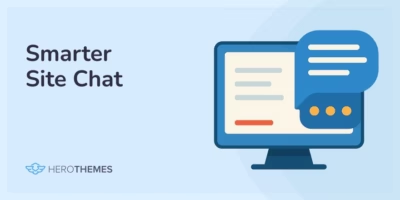10 Support Ticket Response Templates for Fast, Consistent Customer Service
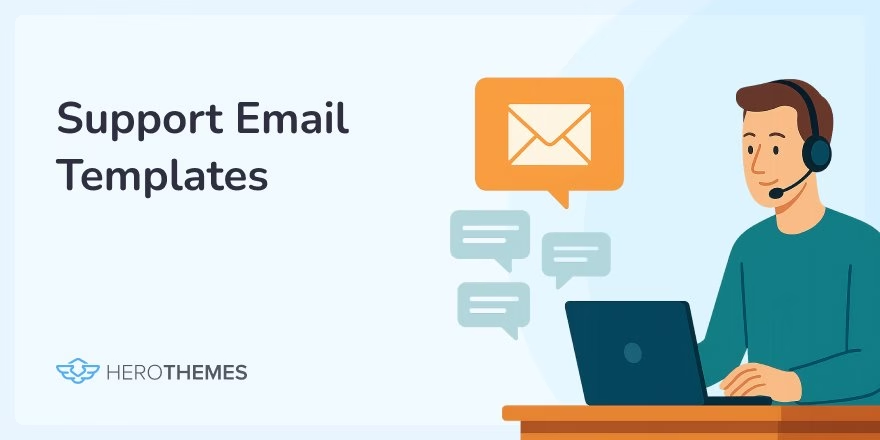
Writing the same support email over and over? Well, that’s the reality of working at support, and it’s frustrating.
Doing that manually for every ticket waste time and produces inconsistency. This is where support ticket response templates (aka help desk canned responses) come in to save the day!
In this guide, I’ll share help desk ticket response templates for common customer service scenarios. Each template comes with an example you can tweak for your business.
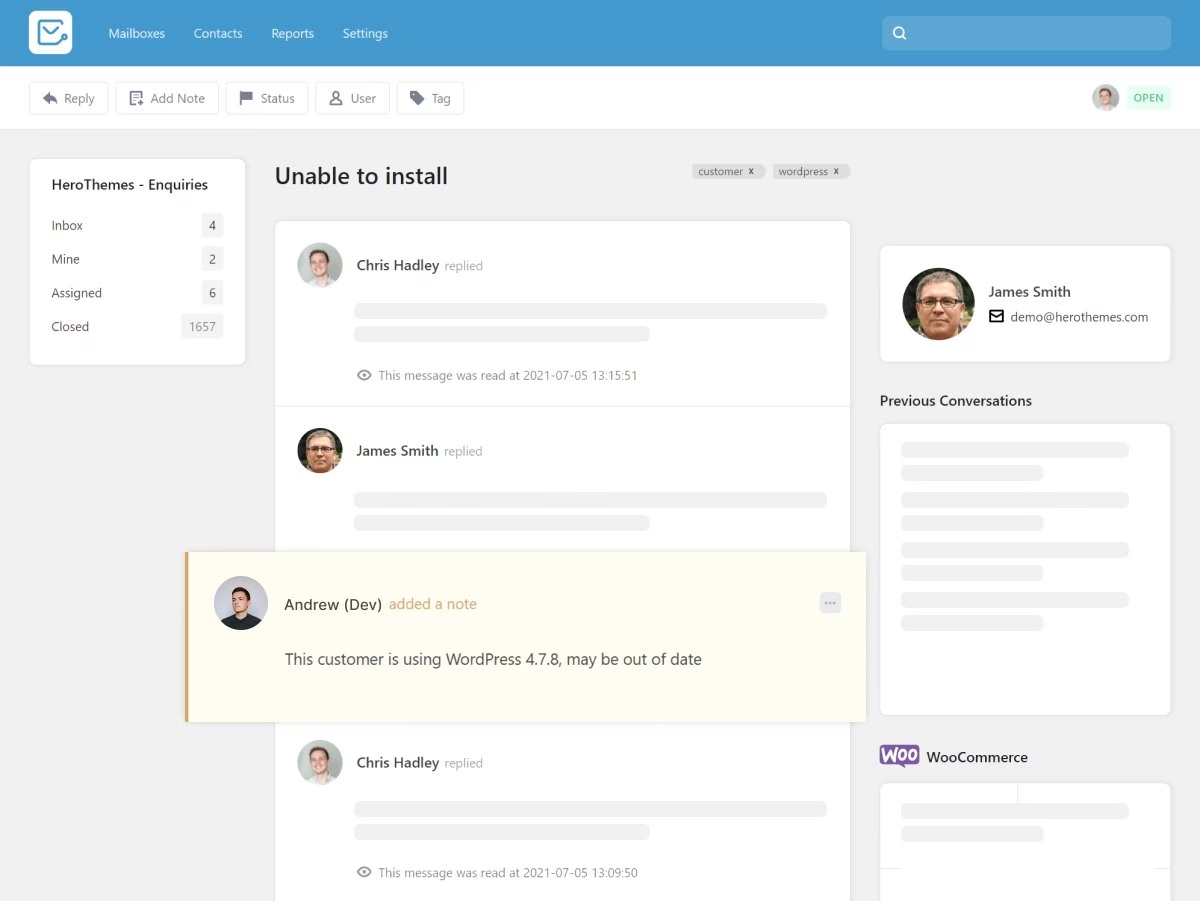
Heroic Inbox
A simple and affordable helpdesk for small businesses.
All plans include unlimited users and tickets.
In This Guide
- What Are Help Desk Response Templates?
- Benefits of Using Support Ticket Templates
- 10 Support Ticket Response Templates (Examples Included)
- 1. Ticket Received Acknowledgment
- 2. Request for More Information
- 3. Sharing a Knowledge Base Article
- 4. Ticket Escalation Notice
- 5. Status Update on a Pending Issue
- 6. Issue Resolved Confirmation
- 7. Apology for Mistake or Inconvenience
- 8. Refund Process Initiated
- 9. Feature Request Acknowledgment
- 10. Post-Resolution Customer Feedback Request
- 1. Ticket Received Acknowledgment
- Best Practices for Using Canned Responses Effectively
What Are Help Desk Response Templates?
Help desk response templates (also known as canned responses or service desk ticket templates) are basically pre-written messages for common support scenarios. They provide a starting point that agents can customize, instead of typing a fresh reply from scratch each time.
The template includes the basic information, and your support representative just fills in the specifics, such as the customer’s name, order details, or issue description, before sending.
Modern help desk software like Heroic Inbox usually includes a canned response or template library feature to manage these.
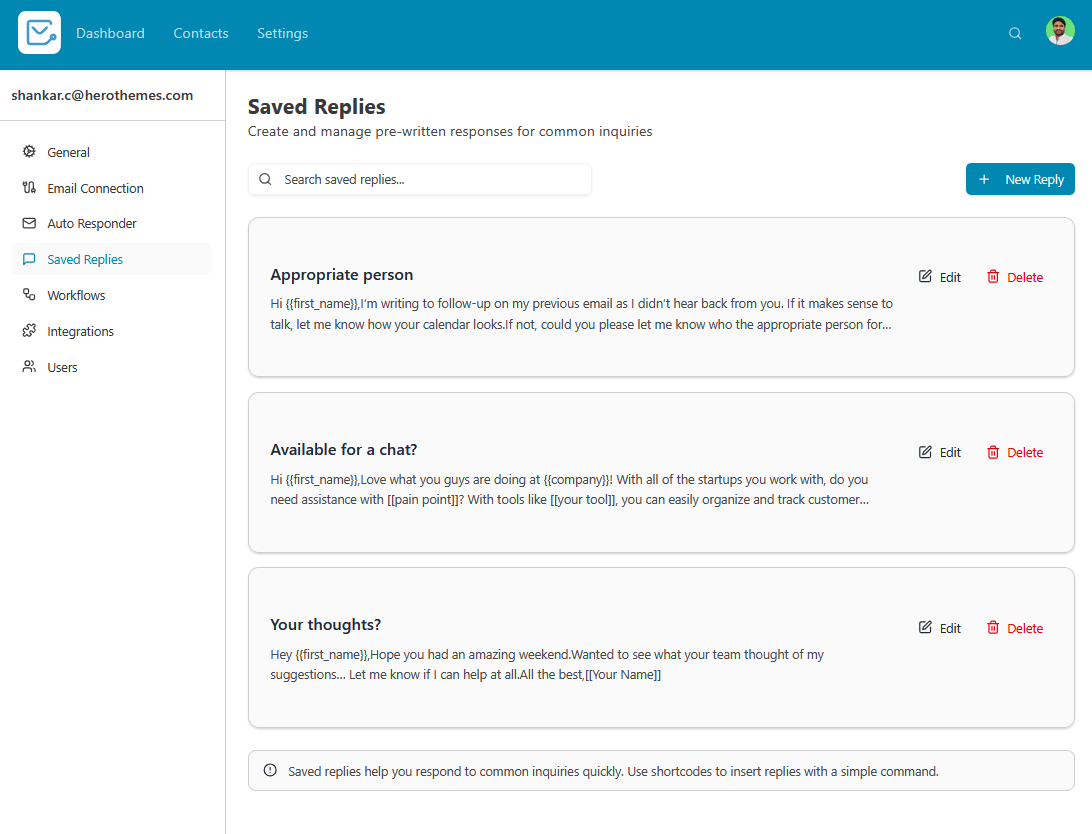
You can import them with a few clicks from the editor itself when needed. This eliminates the need for copy-pasting.
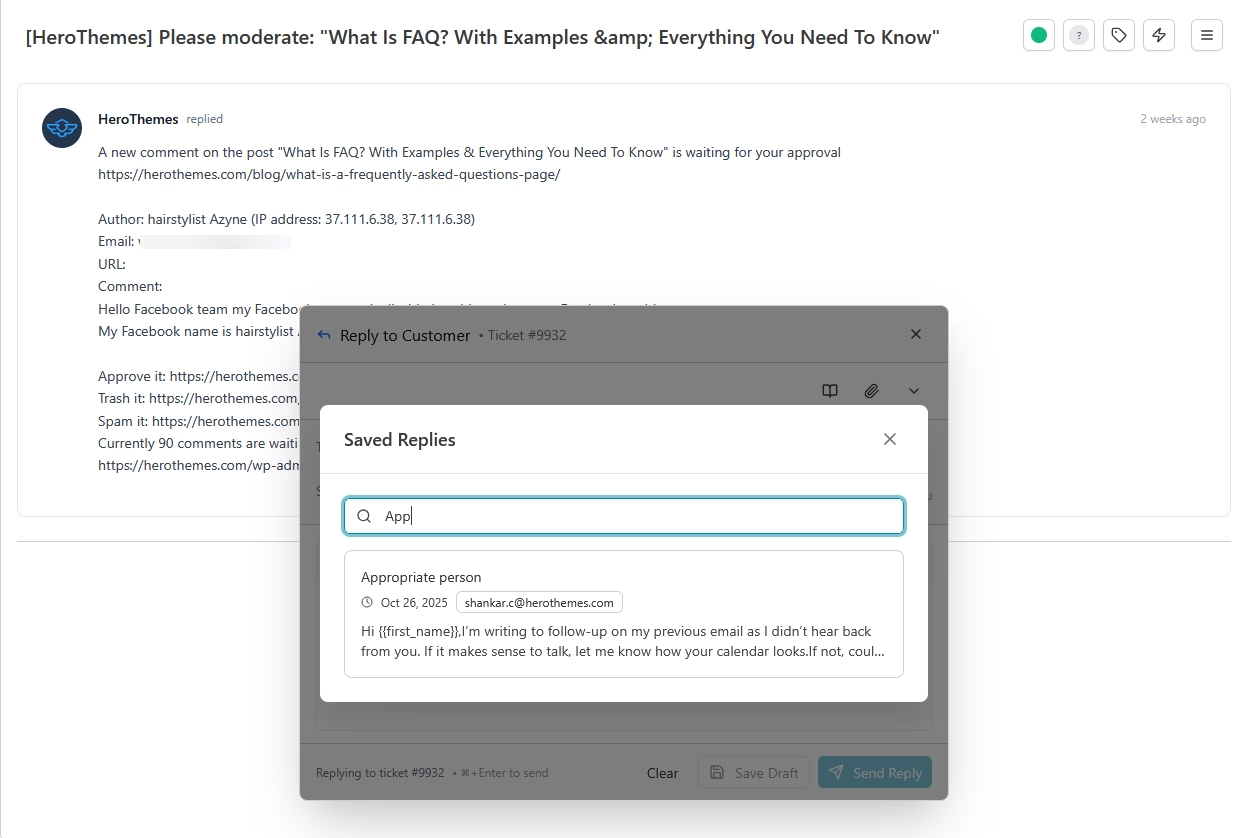
Benefits of Using Support Ticket Templates
Simply put, a library of customer service response templates will supercharge your team’s efficiency and consistency.
Below are some major benefits of using templates:
- Lightning-fast responses: With templates on hand, agents can fire off answers in seconds instead of minutes.
- Consistent communication: Templates ensure every agent is giving out accurate, uniform information.
- Saved agent effort (and sanity): Handling the same simple questions 100 times a week is a recipe for burnout. A good template library cuts down the mind-numbing repetition, so your team can focus on the more challenging and fulfilling tasks.
- Unified brand voice
- Easier training for new agents: Templates provides examples of how to properly handle common questions. New team members can learn standard answers and tones by using these templates, which accelerates their transition into the role.
- Higher support capacity: Quick template use = more tickets answered per hour. Your current staff can handle a higher volume of inquiries without sacrificing quality, which can save on hiring extra personnel.
- Boosts customer satisfaction
10 Support Ticket Response Templates (Examples Included)
Now, onto the good stuff—the actual templates. I’ve covered different scenarios to give you a good idea of how to effectively use these canned responses.
Remember, these are starting points. You should customize the wording to fit your product, policies, and personality.
1. Ticket Received Acknowledgment
When a customer submits a support ticket (or email your help desk). If you don’t have an answer right away, it’s important to acknowledge you got their request.
This first reply sets expectations and reassures the customer that you’re on it.
Many teams send an automated response immediately upon ticket submission.
Ticket Acknowledgment Template example:
Hi [Customer Name],
Thank you for reaching out to [Your Company]! We’ve received your request and it’s been logged in our system under ticket ID [#12345]. Our support team is already looking into it. 👍
You can expect an update from us by [estimated timeframe, e.g. “the end of today”]. In the meantime, if you have any additional details to add, just reply here and let us know.
Thank you for your patience, and we’ll be in touch soon!Tips:
- Keep the response short and sweet. For example, the above template thanks the customer, confirms receipt, and gives a rough timeline for a full response.
- Make sure you deliver on a given timeframe or send an update if it’s going to take longer.
- Adjust formality based on your brand. It’s best to strike a balance between professional and personable.
- Automate this acknowledgment with your help desk software.
2. Request for More Information
You get tickets that lack crucial details, or you need clarification about the problem. E.g., the user says “It’s not working” but you need logs or steps to reproduce the issue.
Here you send a focused request for the specific info you need.
Response Template for Requesting More Details About an Issue:
Hello [Customer Name],
Thank you for contacting us! I’m sorry you’re experiencing [brief description of the issue].
To help us get to the bottom of this, could you please provide a bit more information? Specifically, it would be super helpful if you could let us know:
– [Key Detail 1] (e.g. the exact error message or code you see)
– [Key Detail 2] (e.g. what you were doing right before the issue happened)
– [Any relevant screenshots or files] that might help illustrate the problem
Once we have these details, we’ll be able to assist you much more effectively.
Thanks in advance for your cooperation! We really appreciate it and want to get this resolved for you ASAP.
Regards,
[Your Name] | [Support Team or Company Name]In this template, I kept the tone helpful and didn’t blame the customer for not including info initially.
It uses bullet points to clearly outline what I exactly need. This makes it easy for the user to respond point-by-point.
And don’t forget to thank the customer for cooperating with you.
3. Sharing a Knowledge Base Article
In many cases, you already have a knowledge base article that solves the exact same problem. It is just, the customer was unable to find it at that moment or didn’t know about it.
This is a chance to empower the user to self-serve the solution.
If you have a knowledge base or help center, you should absolutely leverage it in your ticket responses. By sending them a helpful article, you not only solve their issue but also teach them how to find info in the future.
Support Response Template for Sharing a Knowledge Base Article:
Hi [Customer Name],
Great question!
We actually have a step-by-step guide that covers exactly how to [solve their issue or answer their question].
You can check it out here: [Knowledge Base Article Title] (link to the article). It walks through the process and should get you sorted out.
Please take a look at that article and let me know if it resolves your issue.
If anything is unclear or doesn’t work as described, just reply and I’ll be happy to help further. Our goal is to make sure you’re all set!
Thanks, and have a wonderful day!
[Your Name]Tips:
- Point directly to the article
- Keep the response tone enthusiastic and encouraging
- Always leave the door open so the customer doesn’t feel you’re dumping them in a DIY alley.
A tool like Heroic Knowledge Base (Heroic KB) makes it easy to organize help articles on your website and even integrate them into your support workflow.
For instance, you can pair Heroic KB with Heroic Inbox so that agents can find relevant knowledge base articles and insert them into an email without switching tabs. You can also get an AI helper that suggests relevant articles on the fly.
4. Ticket Escalation Notice
Not all problems can be solved at the first level of support. Maybe the issue is complex, a potential bug, or requires approval from higher-ups.
When you need to escalate a ticket (to Tier 2/3 tech support, a specialist, or a manager), you should inform the customer about it.
Support Response Template for Ticket Escalation:
Dear [Customer Name],
Thank you for your patience while we’ve been looking into [the issue].
I wanted to let you know that I’m escalating your ticket to one of our [senior specialists/engineers] for further analysis. This issue appears to require deeper expertise, and I believe involving our [specialist team] is the fastest way to get it resolved for you.
Meanwhile, I’ll continue to monitor the progress to ensure your case gets the attention it deserves.
We appreciate your understanding, and rest assured we’re doing everything we can.
You can expect our next update by [timeframe].
Thank you,
[Your Name]This escalation ticket template is all about transparency and reassurance.
It explains why the escalation is happening and emphasizes that it’s a positive thing.
5. Status Update on a Pending Issue
Sometimes fixes take longer than expected. Maybe parts are on backorder (for a hardware fix), the dev team needs more time to squash a bug, or you’re waiting on a third-party.
Instead of radio silence, it’s crucial to keep the customer in the loop.
This shows the customer you haven’t forgotten them.
Support Response Template for Status Update:
Hi [Customer Name],
I wanted to give you a quick update on your ticket [#12345] regarding [issue].
Our team is still actively working on this. We haven’t found the complete solution yet, but I can tell you we’ve made progress on [some aspect, if applicable].
At this stage, the issue is still under investigation. We’re doing everything we can to resolve it, including [mention any specific actions, e.g. “consulting with our product engineers” or “testing a fix in our staging environment”].
I know it’s frustrating to wait, and I’m sorry this is taking longer than hoped. 🙏
We will update you again by [next update timeframe, e.g. “tomorrow afternoon”] at the latest to let you know where things stand.
Thank you so much for your patience. If you have any questions or new information in the meantime, please let me know.
Sincerely,
[Your Name]Tips:
- Keep the tone for such emails understanding and apologetic without groveling.
- Always apologize for delays, even if it’s not your fault.
- Let the customer know what’s happening behind the curtain.
- Show commitment to resolve the issue as soon as possible.
6. Issue Resolved Confirmation
Good news, the support issue has been fixed!
Once you’ve solved the problem, you should close the loop with the customer.
This template delivers the happy news and provides any relevant details about the fix.
Support Response Template Example:
Hi [Customer Name],
Great news: We believe we’ve resolved the [brief description of the issue]! 🎉
Our team [explain in one sentence what was done – e.g. “reset your account permissions” or “deployed a patch in version 3.2.1”].
You should now be able to [use the product as intended/do the thing that was broken] without any problems.
Could you please check on your end to confirm that everything is working correctly for you now?
If you’re still seeing any issues, let me know and we’ll continue to assist. But we’re pretty confident this does the trick.
I want to thank you for your patience while we worked on this.
We’re always here to help, so don’t hesitate to reach out if you need anything else. For now, I’m glad we could get this sorted out for you!
Best regards,
[Your Name]Keep the message simple, no need to drown them in technical jargon.
The crucial part is asking the customer to verify on their side. You’d be surprised how often something is thought fixed but the user still has an edge case.
For me, the best part about customer support is getting that reply “Yes, all good now, thanks so much!”. A satisfying conclusion for both sides
7. Apology for Mistake or Inconvenience
Sometimes the fault lies on your side.
A bug caused data loss, a support agent gave the wrong info, an order got mishandled, or an SLA was missed.
When the company has made an error or the customer had a bad experience, a sincere apology is in order.
It’s tough to admit mistakes, but doing so transparently can actually increase customer loyalty (people appreciate honesty and accountability). This template can be used when you need to apologize and take ownership, whether it’s for a specific error or generally for not meeting expectations.
Example of an Apology Response Template:
Dear [Customer Name],
I’m reaching out regarding your experience with [issue/service].
First and foremost, I want to apologize for [what went wrong]. This is not the level of service we aim to provide, and I’m truly sorry for the inconvenience and frustration this has caused you. 🙏
Here’s what happened: [Briefly explain the mistake or the cause of the problem, if appropriate].
More importantly, here’s what we’re doing to fix it: [Explain the corrective action being taken].
I understand that an apology doesn’t undo your negative experience, but I hope it shows that we take this seriously.
If there’s anything else we can do to make this right for you, please let me know.
Sorry once again, and thank you for your patience. We value your business and will work hard to regain your trust.
Sincerely,
[Your Name] – [Position], [Company Name]The structure should be here: Apologize unreservedly, explain the situation (without deflecting blame), describe the fix/prevention, and apologize again.
Avoid any pseudo-apologies like “I’m sorry if you were inconvenienced” (that sounds like you’re not owning it fully). Instead: We messed up, we’re sorry, here’s how we’ll do better.
An honest apology like this can turn an angry customer into a loyal one because they see you genuinely care.
8. Refund Process Initiated
When processing a refund, it’s good practice to notify the customer once it’s initiated and let them know what to expect.
This email template confirms the refund and provides any necessary details (amount, timeframe, how it will appear, etc.).
Refund Email Response Template:
Hello [Customer Name],
I’m writing to confirm that we have processed your refund for [product/service name or description].
The refund amount is [Currency][Amount], and it has been issued to the [original payment method – e.g., “credit card ending in 1234” or “PayPal account”] you used for the purchase.
Please note that it may take [X business days] for the refunded amount to appear in your account. (The exact timing depends on your bank or payment provider.)
You should receive an email receipt/confirmation from our system shortly as well.
I’m sorry that [the product/service] didn’t meet your expectations (we never want to disappoint our customers).
We appreciate you giving us a try. I’ve ensured the refund was processed promptly per our satisfaction guarantee, and you should see the funds soon.
If you have any questions about the refund, or if there’s anything else I can assist you with, please let me know.
Thank you for your patience throughout this process.
Sincerely,
[Your Name]When money is being returned, clarity is key. This template clearly states the amount and where it’s going.
And even if it’s a no-questions-asked refund, expressing regret that they didn’t get what they needed shows goodwill, and keeps the door open.
Who knows, a gracious refund experience might even make them consider coming back in the future.
So handle refunds emails with as much care as sales.
9. Feature Request Acknowledgment
This scenario is common in software and SaaS, but can happen in any business where customers have ideas.
Rather than just saying “thanks, we’ll think about it” and closing the ticket, it’s good to acknowledge their input and set proper expectations.
Template Example:
Hi [Customer Name],
Thank you so much for your feature suggestion about [brief description of the feature].
We love getting feedback like this. It helps us understand what you need and how we can improve [Your Product/Service].
I’ve gone ahead and shared your idea with our product team for review. 🙌
While I can’t guarantee if or when we’ll add this feature, please know that we take these requests seriously.
Our team will evaluate [the feature] alongside other ongoing projects and user requests.
If we do move forward with it, I imagine it could be included in a future update, but I don’t have a timeline right now.
I really appreciate you taking the time to share this idea, and we’re grateful for that.
And of course, if there’s any other feedback or questions you have in the meantime, I’m all ears.
Thanks again,
[Your Name]This help desk response template is positive and encouraging, but also realistic.
The key here is to thank them enthusiastically and acknowledge the value of their input.
Explore:
23 Subject Lines for Thank You Emails Expressing Honest Gratitude
14 Email Subject Lines to Express Gratitude
10. Post-Resolution Customer Feedback Request
The issue is resolved (or the support interaction is concluding), and now you want to gather feedback on the customer’s experience.
Many support teams send a CSAT (Customer Satisfaction) survey or a simple “How did we do?” after closing a ticket.
This response template can be used as a closing message or a follow-up email to encourage the customer to provide feedback or rate the support they received. It’s a way to show you care about improving and that you value the customer’s opinion.
Post-Resolution Email Response Template:
Hi [Customer Name],
I’m glad we were able to resolve your issue regarding [brief issue] for you! 🙌
Could you spare a few seconds to let us know how we did?
[Feedback Survey Link]
Your feedback helps us continue improving our support.
It’s just one question (with an optional comment box), so it won’t take long.
And of course, if there’s any remaining concerns or new questions, feel free to reply to this email, and I’ll be happy to help. 😄
Thank you for giving us a chance to help you! We really appreciate it.
Sincerely,
[Your Name]
Tips:
- Keep the feedback email and request short. Customers are more likely to give feedback if it’s quick and easy.
- Send this immediately after resolution. This is the best time to get customer feedback.
- You can also automate feedback collection with software like Heroic Inbox.
- If you suspect the customer is unhappy with the resolution, tweak the phrasing to be more open-ended, like “I’d love to hear how your support experience has been and if there’s anything we could have done better.”
Explore:
34 Best Examples of Follow-up Email Subject Lines
The Ultimate Customer Feedback Email Template + Samples
Best Feedback Email Subject Lines
How To Ask for Feedback From Customers
Best Practices for Using Canned Responses Effectively
Having a library of support response templates can revolutionize your workflow, but you must use them wisely.
Here are a few more best practices for effectively using these templates:
- Personalize each response
- Keep the tone human and empathetic
- Don’t send without reading
- Update your templates regularly
- Use the tools like Heroic Inbox
- For very unique or sensitive situations, it might be better to write a fully custom reply.
So go ahead and build your own library of canned responses using the examples above as a starting point. Happy supporting!



